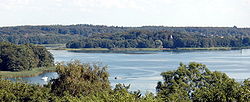Lake Schwerin
| Lake Schwerin (Schweriner See) |
|
|---|---|
 |
|
| Location | Mecklenburg-Western Pomerania |
| Coordinates | 53°38′N 11°28′E / 53.633°N 11.467°ECoordinates: 53°38′N 11°28′E / 53.633°N 11.467°E |
| Type | eutrophic |
| Primary outflows | Wallensteingraben, Stör Canal |
| Basin countries | Germany |
| Max. length | 21 km (13 mi) |
| Max. width | 6 km (3.7 mi) |
| Surface area | 61.54 km2 (23.76 sq mi) |
| Average depth | 12.8 m (42 ft) |
| Max. depth | 52.4 m (172 ft) |
| Residence time | 10.1 years |
| Surface elevation | 37.6 m (123 ft) |
| Settlements | Schwerin, Bad Kleinen |
Lake Schwerin (German: Schweriner See) is a lake in Mecklenburg-Vorpommern, northern Germany. It was named after the city Schwerin, on its southwestern shore. The smaller town Bad Kleinen is on the north shore of the lake. Its surface is approximately 61.54 square kilometres (23.76 sq mi), and its maximum depth is 52.4 metres (172 ft). The natural outflow of the lake is the (channelized) river Stör, a tributary of the Elde, and part of the Elbe watershed. The Wallensteingraben, a 16th-century canal, connects the lake with the Baltic Sea at Wismar.
Map of Schwerin and its lakes, most dominantly the Lake Schwerin with its inner and outer lake area
Aerial view of Schwerin on the lakes
Schwerin Castle on its own island in the Lake Schwerin
Yachting Club at Lake Schwerin
White Fleet, cruiseships at the city's lakeshore
Beach in Zippendorf, a district of Schwerin
The Beutel are of Lake Schwerin
Sunrise at the Marstall peninsula
Schwerin seen from the Lake
Observation tower on Kaninchenwerder, an island of Lake Schwerin
Sunrise at Ziegelwerder island
...
Wikipedia
